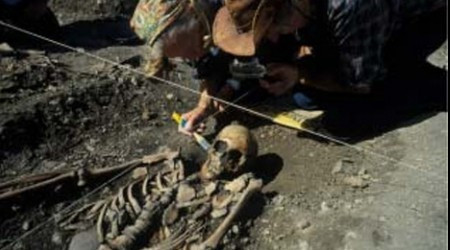DNA Studies Reveal Spread of European Agriculture In Stone Age

DNA studies of four skeletons reveal how agriculture spread in Europe during the Stone Age.
A group of researchers have discovered that some migrants introduced agriculture in Europe. The researchers discovered the four skeletons on the island of Gotland in Sweden. DNA analysis revealed that one of the skeletons was of a female farmer, who lived during the Stone Age, 5,000 years ago.
Researchers have named her Gök4. Gök4 was somewhat similar to modern day Mediterranean people, who live in the Horn of Africa, the Middle East and Asia, according to Nature journal.
"The Stone Age farmer's genetic profile matched that of people currently living in the vicinity of the Mediterranean, on Cyprus, for example," said Pontus Skoglund, researcher at the Uppsala University, in a statement.
The study also revealed that the other three remains were hunters, who belong to the same age.
According to the researchers, agriculture developed in the Middle East about 11,000 years ago and by about 5,000 years ago had reached most of continental Europe. How the spread of agriculture progressed and how it affected the people living in Europe have been debated for almost 100 years.
Earlier, another group of researchers claimed that agriculture came to Europe through word of mouth. They believe that a group of migrants had spread the idea of agriculture.
"Many attempts, including using genetics, have been made to come to terms with the problem since the significance of the spread of agriculture was established almost 100 years ago," said Anders Götherström, researcher at Uppsala University, in a statement. "Our success in carrying out this study depended on access to good material, modern laboratory methods and a high level of analytical expertise."
Now, researchers have discovered that Mediterranean people brought agriculture to Europe. They claim that hunters and Mediterranean people lived side by side for many generations, to eventually interbreed which explains the patterns of genetic variation that characterises present-day Europeans.
"The process appears in the end to have had the result that nobody today has the same genetic profile as the original hunter-gatherers, although they continue to be represented in the genetic heritage of today's Europeans," said Pontus Skoglund.
"Archaeology has become a stimulating interdisciplinary field. We have obtained new, concrete biological data about Stone Age people that provides scope for discussions about origins, mobility and social networks pertaining to a period that has lately been the focus of lively debate. Scientific DNA studies have broadened the basis for engaging discussions within archaeology in recent years," said Jan Storå, researcher at Stockholm University, in a statement.
© Copyright IBTimes 2025. All rights reserved.





















